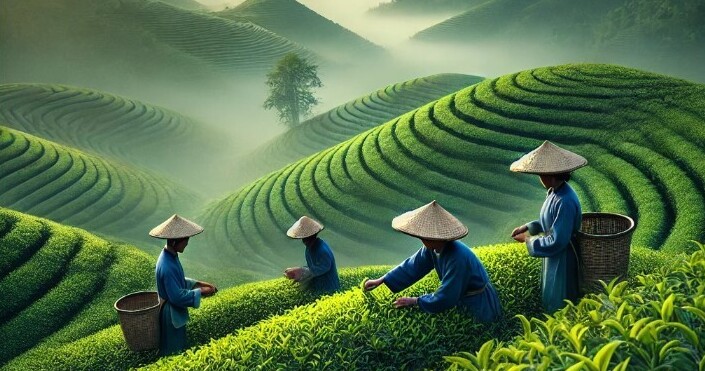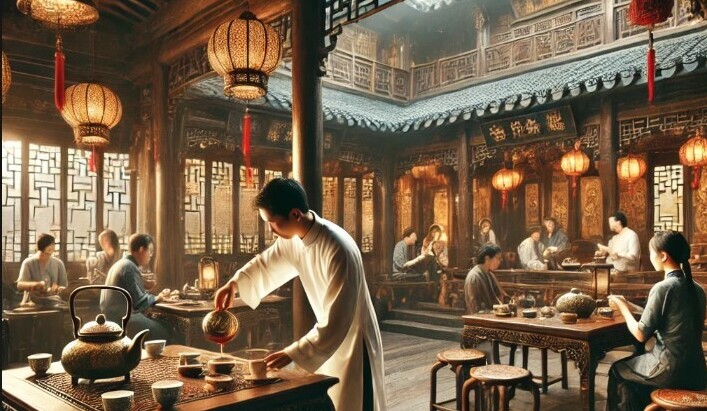
Ever wondered how a simple cup of tea could hold centuries of tradition in every sip? Green tea isn’t just a drink in China—it’s a way of life. It’s history in a cup, a quiet companion through changing times, and a symbol of balance, wisdom, and hospitality.
Picture this: centuries ago, Chinese farmers nurtured their tea plants with the kind of care usually reserved for priceless treasures. Green tea made its way from misty mountain fields to bustling marketplaces, where emperors and commoners alike fell in love with its quiet depth.
But this isn’t just about refreshment—it’s about tradition, respect, and a deep-rooted connection to the land.
Fast forward to today, and green tea is still woven into the fabric of daily life. It’s there in street-side stalls, grand tea houses, and even modern cafés where matcha lattes sit side by side with traditional brews. But what makes green tea so deeply embedded in Chinese culture?
Let’s take a sip through history and explore its significance, traditions, and evolving role in modern life.
Cultural Significance: A Sip Through History
Green tea holds a place of enormous cultural importance in China, deeply woven into the rituals and traditions that define the country’s unique fabric.
Far beyond a simple drink, green tea is an emblem of hospitality and respect, often presented during significant occasions, from weddings to New Year’s celebrations.
For centuries, it has been a symbol of hospitality and respect, appearing in social gatherings, religious ceremonies, and even business meetings.
Imagine stepping into a traditional Chinese home. Before you even sit down, a cup of green tea is placed in your hands. It’s a gesture of warmth and welcome, a silent invitation into conversation.
In tea houses, friends and strangers alike bond over steaming cups, where conversations flow as easily as the tea itself. These gatherings are more than just social—they reflect China’s deep-rooted value of connection.
Deep in the heart of Chinese traditions, tea is a quiet yet profound catalyst. It stands as a metaphor for balance in life, clearly mirrored in the meticulousness of its preparation and the stillness it cultivates in the hearts of those who enjoy it.
Green Tea in Literature and Philosophy
Green tea has also danced through Chinese poetry, philosophy, and literature for centuries. Scholars, monks, and poets found inspiration in its quiet simplicity, using it as a meditative aid to reflect on life’s deeper meanings.
The famous Tang Dynasty poet Lu Tong wrote an entire poem about the seven joys of drinking tea, describing how each sip lifted his spirit to new heights of clarity and peace.
The connection between tea and mindfulness is no accident. Many Chinese philosophers saw tea drinking as a metaphor for life—just as tea must be brewed with patience and care, so too should one approach life with mindfulness and balance.
Even today, tea reminds us to slow down, be present, and savor each moment—one sip at a time.

“Tea tempers the spirits, harmonizes the mind, dispels lassitude, relieves fatigue, awakens thought,
and prevents drowsiness.” — Lu Yu, The Classic of Tea
The Main Types of Chinese Green Tea
With thousands of green tea varieties grown across China, it’s impossible to cover them all—but some have stood the test of time as national treasures. Here are a few of the most famous:
🍃 Longjing (Dragon Well) – Zhejiang Province
If there’s one green tea that stands above the rest in fame, it’s Longjing. Grown near Hangzhou’s West Lake, Longjing tea is pan-roasted, giving it a flat, smooth leaf and a nutty, slightly sweet taste. It was once an imperial tribute tea, enjoyed by emperors and officials alike.
🍃 Biluochun – Jiangsu Province
This delicate tea, whose name means “Green Snail Spring”, is named after its curled leaves that resemble tiny snail shells. It’s famous for its strong floral and fruity aroma, making it one of China’s most aromatic teas.
🍃 Huangshan Maofeng – Anhui Province
Grown in the misty Huangshan (Yellow Mountain) region, this tea is prized for its fresh, mellow taste with a hint of sweetness. Its name, “Maofeng,” refers to its furry buds that give it a unique appearance.
Each of these teas carries the essence of its region, making them more than just a drink—they’re a taste of China’s landscapes, climate, and culture.
Traditions and Practices: Brewing the Perfect Cup
If you think making green tea is as simple as tossing leaves into hot water, think again. In China, brewing tea is an art, a ritual passed down through generations.
Every detail matters—the temperature of the water, the type of teapot, even the way the leaves are poured. Traditional tea ceremonies aren’t just about taste; they’re about mindfulness, patience, and honoring the tea itself.
The Art Of The Tea Ceremony
Tea ceremonies in China are a mindful experience. From the careful selection of the tea leaves to the precise pouring technique, every step holds meaning. The choice of teaware also plays a role—porcelain cups and Yixing clay teapots aren’t just aesthetically pleasing; they actually enhance the flavor by absorbing the essence of past brews over time.
Each movement in the ceremony is deliberate, from the warming of the teapot to the pouring of the first steep, which is often discarded to “awaken” the leaves. Taking part in a tea ceremony isn’t just about drinking—it’s about embracing the moment, appreciating tradition, and connecting with others.
Regional Tea Traditions
Tea culture varies from region to region, each with its own rituals and preferences:
- Fujian – Known for the Gongfu tea ceremony, an intricate process that emphasizes precision and repeated steepings.
- Zhejiang – Home to Longjing (Dragon Well) tea, one of the most famous and highly prized green teas in China, loved for its fresh, slightly sweet taste.
- Sichuan – Famous for tea-pouring performances, where tea masters use long-spouted kettles to pour tea from dramatic distances with incredible skill.
These regional variations highlight how deeply tea is woven into the cultural identity of different parts of China.

Green Tea And Society: Class, Gender And Superstitions
A Drink for All—Or Was It?
Today, anyone can enjoy green tea, but in ancient China, it wasn’t always so accessible. The highest-quality teas were often reserved for the elite, used as tributes to emperors or exchanged as diplomatic gifts between dynasties. Ordinary people, meanwhile, drank simpler, locally grown varieties.
Even the way tea was consumed varied by class. The nobility often enjoyed elaborate tea rituals, while commoners brewed their tea simply, using whatever vessels were available.
Tea and Gender Roles
Tea culture wasn’t just about class—it also had gendered traditions. In some historical periods, women were expected to master the art of brewing tea as a sign of grace and refinement. Meanwhile, men engaged in tea-drinking rituals during intellectual gatherings, where tea fueled philosophical debates and poetry readings.
Today, tea is for everyone, but these historical associations still linger in traditional customs.
Superstitions and Folklore
Green tea also has its share of myths and superstitions. In some regions, spilling tea was considered bad luck, and serving tea with an empty teapot could symbolize cutting ties with a guest. On the other hand, gifting tea was seen as a gesture of goodwill, bringing prosperity and positive energy.
Health and Wellness: The Original Superfood
Long before modern science caught on, ancient Chinese medicine celebrated green tea for its healing properties. Thought to aid digestion, boost energy, and strengthen the immune system, it was more than just a drink—it was a natural remedy.
Even today, research supports many of these claims. Green tea is packed with antioxidants, linked to heart health, brain function, and even weight management. It’s fascinating to see how ancient wisdom and modern science align, proving that green tea’s benefits have truly stood the test of time.
Green Tea in the Modern Era: Tradition Meets Innovation
Green tea isn’t just a relic of the past—it’s a thriving industry and a major player in China’s economy. Entire communities depend on tea farming, and advancements in cultivation have made production more efficient and sustainable.
But perhaps the biggest shift is in how younger generations perceive tea. While their ancestors brewed tea with reverence, today’s youth are embracing it in new ways—matcha desserts, bottled tea drinks, and even tea-infused cocktails.
At the same time, international demand for Chinese green tea continues to grow, with tea exports expanding to countries worldwide. From traditional loose-leaf teas to modern wellness trends, green tea has found its place in both old traditions and contemporary lifestyles.
Frequently Asked Questions (FAQ)
1. What role does green tea play in Chinese traditions?
Green tea symbolizes hospitality, respect, and mindfulness in Chinese culture. It is commonly served to guests, used in tea ceremonies, and plays a role in spiritual and philosophical traditions.
2. How is green tea used in Chinese tea ceremonies?
Traditional Chinese tea ceremonies emphasize precision, patience, and appreciation of the tea’s flavor and aroma. Every step, from selecting the leaves to brewing and pouring, is done with mindfulness and respect for the tea-making process.
3. What are the most famous types of Chinese green tea?
Some of the most well-known Chinese green teas include:
- Longjing (Dragon Well) Tea – Nutty, smooth, and slightly sweet.
- Biluochun – Delicate with a floral and fruity aroma.
- Huangshan Maofeng – Fresh and mellow with a hint of sweetness.
4. What are the health benefits of green tea?
Green tea is packed with antioxidants and has been linked to improved heart health, brain function, weight management, and digestion. Traditional Chinese medicine has long regarded it as a healing beverage.
5. How has green tea evolved in modern China?
While traditional brewing methods remain popular, modern innovations such as bottled green tea, matcha-infused desserts, and tea cocktails have introduced green tea to new generations in China and globally.
Final Sip: A Connection Across Time
From ancient emperors to modern cafés, from elaborate ceremonies to casual sips at home, green tea has never lost its place in Chinese culture. It’s more than a drink—it’s a way of life, carrying traditions that have been passed down for millennia.
At its core, green tea is a symbol of balance: between old and new, simplicity and refinement, nature and humanity. Its role in Chinese traditions continues to evolve, proving that some legacies are not just remembered—they are lived, one sip at a time.

So much insight packed into this, Nina. There’s something special about green tea. I can’t just drink it like I do coffee. Fast. Nor is it best enjoyed watching telly. It’s one of those contemplation brews so the mention of it representing “balance, wisdom, and hospitality” is fascinating. How you describe the tea ceremonies and the different regional varieties like Longjing and Biluochun opened my eyes to the depth of history and care that goes into tea-making. Definitely going to make me appreciate my next cup of green tea all the more!
Thank you so much, Robert! I love how you put that—green tea really does encourage a slower, more mindful experience. It’s amazing how something as simple as a cup of tea can carry so much history and meaning. I’m so glad you found the post insightful, and I hope your next cup of green tea brings you a moment of calm and appreciation!